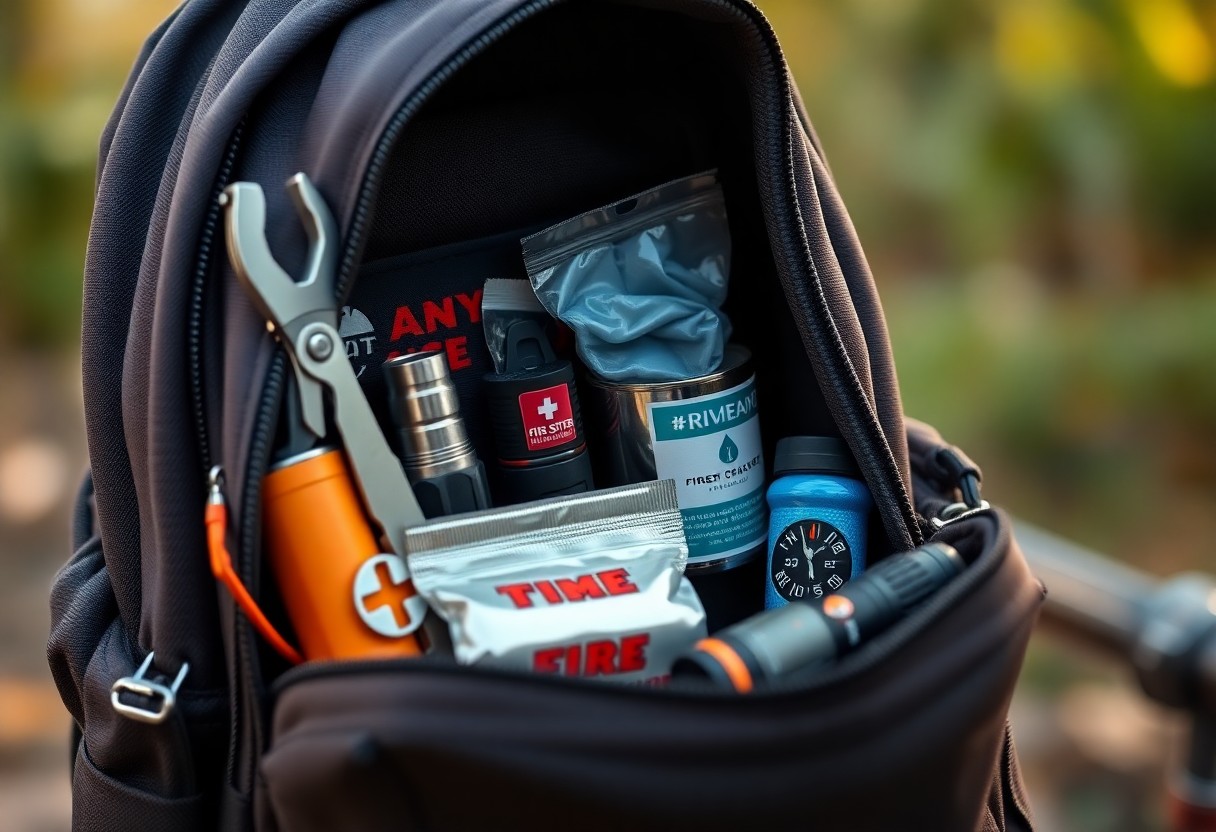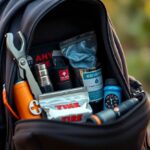Types of Survival Kits
While there are various types of survival kits, you can choose from basic, standard, and premium kits. Some kits are specifically designed for women and include feminine hygiene products. You can consider the following types of kits:
- Basic kits
- Standard kits
- Premium kits
Recognizing your specific needs will help you choose the right kit.
| Kit Type | Description |
| Basic | Includes water, food, and first-aid supplies |
| Standard | Adds shelter and navigation tools |
| Premium | Includes additional items like insect repellent and fire starters |
| Women's Kit | Includes feminine hygiene products and personal protection items |
| Customizable | Allows you to choose items based on your specific needs |
Essential Items for Women's Survival Kits
On the trail, you'll want to make sure you have the right gear. Consider including feminine hygiene products, a whistle, and a personal alarm in your survival kit.
Customizable Survival Kits for Specific Needs
Specific to your needs, a customizable survival kit can be a great option. You can choose items based on your hiking location, weather conditions, and personal preferences.
Customizable survival kits allow you to prepare for specific situations, such as wilderness hiking or urban disasters. Add water purification tablets, extra food, and a first-aid kit to ensure you're prepared. By choosing the right items for your kit, you can increase your chances of survival and stay safe in an emergency.

Key Takeaways:
Factors to Consider
Some key factors to consider when creating a beginner survival kit for women include:
- Personal Health and Safety
- Environmental Factors
Recognizing these factors will help you prepare a kit that meets your specific needs.
Personal Health and Safety Factors
There's a need to consider your health and safety when creating a survival kit. This includes:
- Feminine Hygiene Items
- Personal Protection
You should prioritize these items to ensure your overall well-being in a survival situation.
Environmental Factors and Kit Preparation
One of the most important factors to consider is the environment you'll be in. This includes:
- Weather Conditions
- Terrain
Knowing these factors will help you prepare a kit that includes the necessary items, such as Water, GPS, and Shelter, to keep you safe.
To create a comprehensive survival kit, you should consider the environmental factors that may affect you. For example, if you'll be hiking in an area with Inclement Weather, you'll want to include a rain suit and Warm Clothing in your kit. Additionally, if you'll be in an area with Densely Wooded Terrain, you may want to include a Compass and Map to help you navigate. Knowing these factors and including the necessary items in your kit will help ensure your safety in a survival situation. You can also include a First-Aid kit, Headlamp, and Insect Repellent to be prepared for any situation. Knowing how to use these items is also important for your survival.
Building a Survival Kit
There's no substitute for having a well-stocked survival kit when venturing into the great outdoors. As you assemble your kit, consider the necessaries that will keep you safe and comfortable in case of an emergency.
Step-by-Step Guide to Creating a Basic Survival Kit
The key to a good survival kit is to include the right items. The following table outlines the basics:
| Item | Description |
|---|---|
| Water | At least 2 liters per person per day |
| GPS | A reliable GPS device or smartphone with GPS capabilities |
| Rain Gear | A lightweight rainsuit or poncho |
Advanced Items for Enhanced Survival Capabilities
Little things can make a big difference in a survival situation. Consider adding:
- First-aid kit
- Headlamp or flashlight
- Multi-tool or pocket knife
The following table highlights some advanced items to consider:
| Item | Description |
|---|---|
| Fire starter | Lighter, waterproof matches, or fire cubes |
| Insect repellent | SPF 30 or higher, and permethrin-treated clothing |
Step by step, you can enhance your survival capabilities by adding these advanced items to your kit. Remember to always check local laws and regulations before carrying certain items, such as firearms or knives. As you assemble your kit, prioritize the items that will keep you safe in case of an emergency. With the right gear and a little practice, you'll be well-prepared for your next outdoor adventure.
Survival Tips for Women
Many women face unique challenges when it comes to survival situations. To stay safe, consider the following tips:
- Carry a GPS device or a compass
- Know how to use your first-aid kit
- Be prepared for inclement weather
Knowing your surroundings and being prepared can make all the difference in a survival situation.
General Survival Tips and Tricks
You will want to be prepared with the right gear and knowledge. Consider the following:
- Navigation tools
- Shelter options
- Fire starting techniques
After taking the time to learn these skills, you will be better equipped to handle any situation that arises.
Women-Specific Survival Considerations
For women, there are additional considerations to keep in mind when it comes to survival situations. This includes carrying feminine hygiene items and considering personal protection options.
Tips for women in survival situations include being prepared and aware of their surroundings. It's also important to carry a whistle and know how to use it to signal for help. Additionally, women should consider carrying a personal alarm or pepper spray for self-defense. By taking these precautions and being educated on survival techniques, women can stay safe in emergency situations. With the right gear and knowledge, women can feel confident and prepared to handle any situation that arises.
Evaluating Pros and Cons
For any beginner survival kit, it's crucial to weigh the advantages and disadvantages. The following table breaks down the key points to consider:
| Pros | Cons |
|---|---|
| Easily accessible | Additional weight |
| Increased sense of security | Cost of purchasing a kit |
| Basic necessities for survival | Limited space for customization |
You should consider these factors when deciding what to include in your survival kit.
Benefits of Having a Survival Kit
Consequently, having a well-prepared survival kit can provide you with a sense of security and confidence when venturing into the outdoors. This can be especially important for women who may be more vulnerable in certain situations.
Potential Drawbacks and Limitations
The drawbacks of a survival kit can include additional weight and cost. However, these can be mitigated by carefully selecting the most crucial items and choosing a lightweight and affordable kit.
A closer examination of the potential drawbacks reveals that the weight of the kit can be a significant concern, particularly for beginners who may not be accustomed to carrying heavy packs. Additionally, the cost of purchasing a kit can be a barrier for some individuals. However, it's crucial to consider the long-term benefits of having a survival kit, including the potential to save lives in emergency situations. You should carefully evaluate these factors and consider your specific needs and circumstances when selecting a survival kit.

Step-by-Step Guide to Using a Survival Kit
All the items in your survival kit should be used in a specific order to ensure maximum efficiency and safety. The following table breaks down the steps:
| Step | Action |
|---|---|
| 1 | Locate your survival kit and assess the situation |
| 2 | Use your GPS to determine your location and find a way back |
Deploying the Kit in Emergency Situations
To effectively deploy your survival kit in emergencies, stay calm and follow the steps outlined in your kit. This will help you respond quickly and increase your chances of survival.
Maintenance and Update of the Survival Kit
You should regularly check your survival kit to ensure all items are still usable and not expired. This includes checking the battery life of your GPS and the expiration dates of your food and First-Aid supplies.
Maintenance of your survival kit is extremely important to ensure it remains effective in emergencies. You should check your kit every 6 months to ensure all items are still in working condition and restock as necessary. This will help you stay prepared and increase your chances of survival in case of an emergency. Additionally, you should consider updating your kit with new items or technologies that can improve your survival chances, such as a personal locator beacon (PLB) or a satellite phone.
Understanding Survival Priorities
Despite the numerous survival kits available, it's crucial to understand your priorities in emergencies. You should focus on the most critical elements that will keep you safe and alive.
Prioritizing Needs in Emergency Situations
For instance, when faced with a survival situation, you need to prioritize your needs, starting with water, shelter, and food. These necessities will help you sustain yourself until help arrives or you find your way back to safety.
Adapting to Different Survival Scenarios
Even in unexpected situations, you can adapt and increase your chances of survival. You should be prepared for various scenarios, such as natural disasters or getting lost, and have the necessary items in your survival kit to help you cope.
Adapting to different survival scenarios requires flexibility and quick thinking. You should be able to assess your situation and use the items in your kit to start a fire, find shelter, and signal for help. By being prepared and knowing how to use your survival kit, you can increase your chances of survival and stay safe until help arrives. Staying calm and conserving energy is also critical in survival situations, as they will help you make rational decisions and avoid exhaustion.
Final Words
With this in mind, you now have a solid foundation for creating your beginner survival kit as a woman. You can confidently venture into the outdoors, knowing you have the crucial items to keep you safe and prepared. Remember to regularly review and update your kit to ensure you're always ready for any situation, and don't hesitate to seek additional knowledge and skills to enhance your outdoor experiences.





